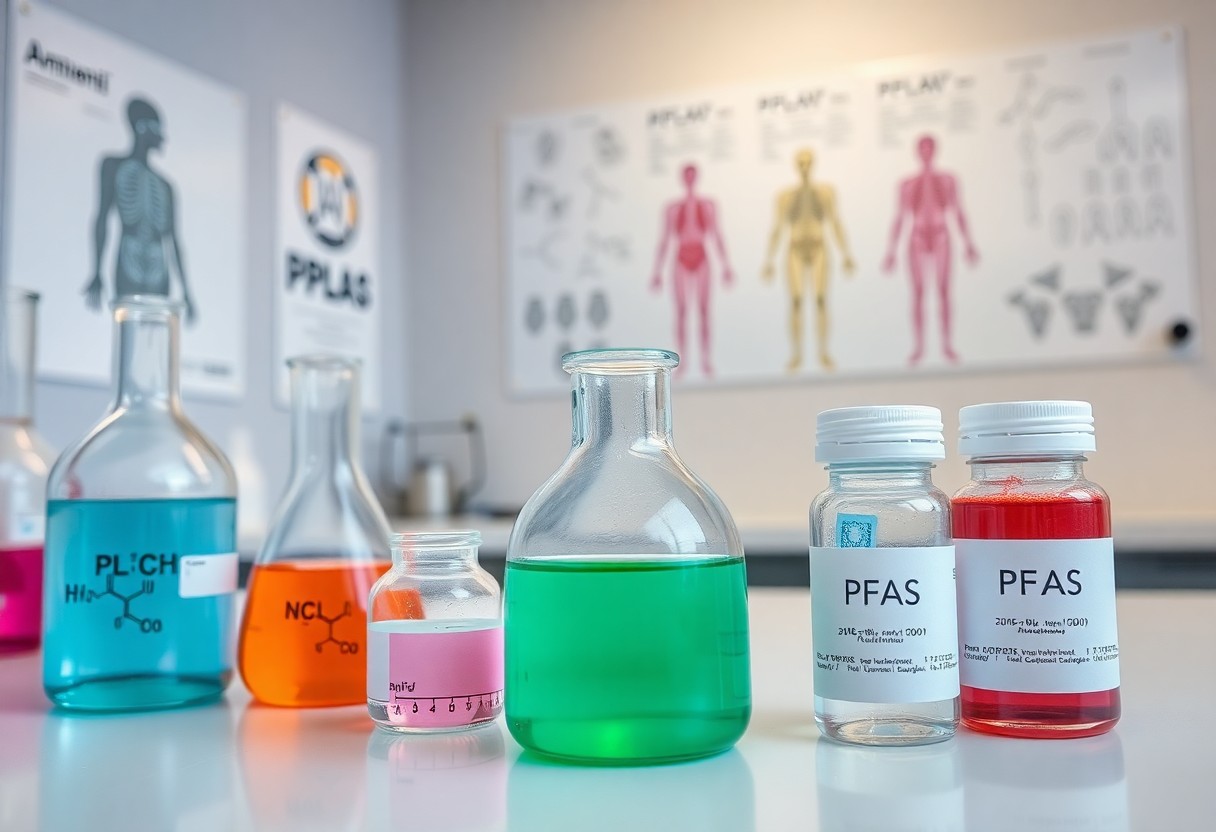Over the past few years, PFAS (per- and polyfluoroalkyl substances) have emerged as a significant environmental and public health concern, affecting your water supply and overall well-being. Known as “forever chemicals” for their persistence in the environment, these substances are linked to serious health risks, including cancer and liver damage. As awareness grows, the fight against PFAS contamination is gaining momentum, urging you to stay informed and advocate for positive change in your community. With ongoing research and regulatory movements, the battle to protect your water has only just begun.
Understanding PFAS
PFAS, or per- and polyfluoroalkyl substances, are a group of human-made chemicals widely used for their water- and grease-resistant properties. You may encounter these substances in everyday products such as non-stick cookware, stain-resistant fabrics, and food packaging. This persistent class of chemicals has raised health concerns due to their potential effects on human health and the environment. Your awareness of PFAS is the first step in combating this contamination.
Definition and Types of PFAS
Adequate knowledge of PFAS is vital as it encompasses a variety of compounds. Here are some key types:
| PFOS | Used in stain repellents and firefighting foams |
| PFOA | Previously used in the production of Teflon |
| GenX | Developed as a replacement for PFOA |
| PFBS | Found in some cleaning products |
| PFDA | Used in industrial applications |
Thou can deepen your understanding of PFAS by exploring their types and applications.
Sources of Contamination
Contamination of water sources can largely be traced back to industrial operations, agricultural runoff, and firefighting practices. Various facilities— including chemical plants, waste sites, and even military bases— can contribute to PFAS on local water supplies. It’s vital for you to recognize these sources to take preventive actions.
Hence, awareness of the different sources of PFAS contamination is fundamental in understanding its impact. Industrial discharges are a significant contributor, often releasing harmful chemicals into nearby water bodies. Similarly, agricultural runoff from the use of certain fertilizers and pesticides can introduce PFAS into your drinking water. Firefighting foam, commonly used during emergencies, can seep into soil and waterways, compounding the problem. By pinpointing these sources, you can better arm yourself with knowledge to advocate for cleaner water solutions.
Health Impacts of PFAS
Even as awareness of PFAS contamination grows, you should be aware of the potential health impacts these chemicals pose. Studies indicate that exposure to PFAS can lead to numerous health issues, affecting systems in your body in both short and long-term ways. The science is still evolving, but the data presents a concerning picture for your health.
Short-term Effects
Across various studies, short-term exposure to PFAS has shown to be linked to symptoms such as fatigue and skin irritations. You may also experience disruptions in your immune response, increasing your vulnerability to infections. These immediate effects, though concerning, pave the way for the more severe long-term health consequences that can arise from persistent exposure.
Long-term Health Risks
Across the spectrum of research, long-term exposure to PFAS has been associated with serious health issues, including thyroid disorders, various cancers, and reproductive complications. You should take into account that the cumulative effect of PFAS can lead to chronic illnesses that may require ongoing medical management.
Indeed, the implications of long-term PFAS exposure extend beyond immediate health concerns. Increased risk factors include a higher likelihood of developing kidney and testicular cancers, as well as high cholesterol levels. You may also face challenges with hormonal disruptions, impacting systems that regulate metabolism or fertility. The long-lasting nature of PFAS in your bloodstream makes awareness and proactive measures crucial to safeguard your well-being.
Current Regulations and Guidelines
Some existing regulations and guidelines concerning PFAS (per- and polyfluoroalkyl substances) water contamination are still evolving, as the health risks associated with these chemicals become clearer. While the federal government has begun addressing PFAS contamination, there is still a need for more comprehensive and enforceable standards to ensure the safety of drinking water across the nation.
Federal Standards
By establishing minimal federal standards, the U.S. Environmental Protection Agency (EPA) aims to reduce the acceptable levels of PFAS in drinking water. However, as these federal standards are often advisory rather than enforceable, the burden falls on states and local authorities to develop their own regulations to protect public health.
State-level Initiatives
After recognizing the potential harm of PFAS, many states have begun to implement their own initiatives to regulate these chemicals in water sources. States like California and Michigan are leading efforts by setting lower maximum contaminant levels and actively monitoring water supplies for PFAS presence.
Guidelines vary widely by state, with some establishing strict regulatory limits on PFAS in drinking water and others focusing on public awareness and education. In states actively combating PFAS contamination, you may find programs promoting water testing and strategies for clean-up. Furthermore, initiatives to monitor industrial discharges are increasingly being put in place, empowering communities to hold polluters accountable. These state-level actions are imperative in the ongoing battle against PFAS contamination, as they fill the gaps left by insufficient federal regulations.
Community Action and Advocacy
Many individuals and groups are stepping up to tackle PFAS water contamination head-on. Through community action and advocacy, residents are raising awareness about the risks associated with these chemicals and demanding action from local, state, and federal governments. Mobilizing your community can empower you to push for stricter regulations, promote local solutions, and hold polluters accountable, contributing to a healthier environment for everyone.
Grassroots Movements
Any movement starts from the ground up, and grassroots efforts are vital in the fight against PFAS contamination. These initiatives often consist of ordinary citizens united by a common goal: to ensure clean and safe water for their communities. By organizing rallies, petitions, and educational campaigns, you can amplify your voice and influence policy changes that prioritize public health.
Legal Battles
For communities facing PFAS pollution, legal battles can often become a necessary course of action. Lawsuits against companies responsible for contaminating water sources are on the rise, as affected residents seek justice and remediation. These legal proceedings can help hold polluters accountable for their actions while providing financial compensation for health concerns and cleanup efforts, promoting a safer environment for you and future generations.
Understanding the complexities of legal battles surrounding PFAS can empower you to advocate more effectively. Many lawsuits are based on the principle that companies knew about the dangers of their products but failed to disclose them, putting your community at risk. The results of these cases may not only lead to necessary funding for cleanup projects but also influence policy reforms that set higher standards for industrial regulation. Engaging in these efforts allows you to play a vital role in protecting your health and environment, making it clear that action against PFAS is not just a legal obligation but a moral imperative.

Technological Solutions
Unlike traditional methods, innovative technological solutions are imperative in the fight against PFAS water contamination. As awareness grows, researchers are investing in advanced techniques to reduce and eliminate these persistent substances from our water sources, aiming to safeguard your health and the environment.
Water Treatment Advancements
Around the world, scientists are developing cutting-edge water treatment technologies that specifically target PFAS compounds. These advancements include electrochemical oxidation and membrane filtration methods, streamlining the process of removing harmful substances from your drinking water.
Emerging Filtration Methods
Along with traditional filtration systems, new approaches are becoming available in the fight against PFAS. Innovative media filters and adsorption technologies are being designed to specifically trap and remove PFAS chemicals, offering more effective solutions for your household and municipal water supplies.
Water treatment facilities are increasingly incorporating these emerging filtration methods to combat PFAS contamination. You should be aware that options like activated carbon filters and ion exchange systems are gaining traction, as they efficiently capture PFAS molecules while allowing clean water to pass through. By staying informed about these advancements, you can make educated decisions and advocate for better water quality measures in your community.
Future Directions in the Fight Against PFAS
Keep in mind that tackling PFAS contamination will involve coordinated efforts at multiple levels, from local communities to national policies. As awareness of the issue continues to grow, embracing innovative technologies and robust frameworks will be necessary in creating lasting solutions to protect your water supply.
Research and Innovation
Directions in research and innovation are vital as scientists and engineers work to develop new methods for detecting and removing PFAS from water. Innovative filtration systems, advanced chemical treatments, and bioremediation techniques are being explored to improve water quality, ensuring your access to safe drinking water.
Policy Recommendations
At this juncture, it’s imperative that you advocate for comprehensive regulatory measures addressing PFAS. Implementing stricter limits on permissible PFAS levels in drinking water, as well as promoting transparency regarding testing results, will empower communities to take informed actions.
And it’s necessary that states establish clear guidelines for acceptable PFAS levels, ensuring that *all communities receive safe drinking water*. Equally important, increased funding for research initiatives will enhance understanding of PFAS‘ impact on health and the environment. Advocating for public education campaigns will enable you and your neighbors to make informed decisions regarding water use, ultimately leading to improved community health outcomes.
To wrap up
Considering all points, it is clear that the fight against PFAS water contamination is just beginning, and you play a vital role in this ongoing battle. As awareness grows and regulations evolve, you must stay informed about potential health risks and advocate for clean water in your community. Engaging with local leaders, supporting educational initiatives, and demanding transparency can help you contribute to a safer environment for all. This is not just a public health issue; it’s a call to action for you to protect your water resources and future generations.



















